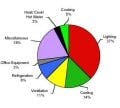The ROI of LEDs: saving money with energy efficient sources, programs and initiatives
LEDs have aroused the interest of designers and installers with promises of a longer lifespan, higher brightness, and a reduction in heat emissions and harmful lighting effects. Awareness has spread, but those making the purchasing decisions are still shying away from the higher cost of these new bulbs as compared with traditional lights. Why buy a $25 LED when you can buy a 90-cent bulb?
However, the most overlooked feature of LEDs is the life, cost and energy savings involved. Many have not fully explored the costs associated with LEDs and the return on making the initial investment, whether it's through a drastically reduced electrical bill, service frequency, or bulb replacement costs.
Looking even further, the advent of the LED has helped raise an even bigger issue surrounding integration - that there are a large number of incentives and rebates available to companies that use efficient energy sources. Upon closer examination of these programs and initiatives, it is evident that the initial investment made towards LEDs and other energy-saving tools is quickly returned.
Case studies
To begin to illustrate the value of energy re-evaluation, a few examples are necessary. In 2001, the City of Portland replaced 6,900 red and 6,400 green incandescent traffic lights with LEDs. The project resulted in annual energy and maintenance savings of $400,000, as well as 1,400 hours of maintenance staff time, and a net payback in less than three years. Since the city entered into a leasing arrangement for the project, they also qualified for Oregon's Business Energy Tax Credit, through which the leasing company receives a 35 percent tax credit over time, reducing the cost of the city's lease by about 22 percent and saving the city nearly $500,000.
In September 2004, Marriott International, with 2,600 owned or franchised lodging properties in nearly 70 countries, entered into a 15-property deal to participate in the Building Tune-Up (BTU) Program from Quantum Consulting. The latter company's engineers identified more than $1.7 million in energy savings across multiple Marriott properties. Quantum's BTU Program was estimated to result in $200,000 to $500,000 in annual savings for some of the 15 individual Marriott properties.
Commercial energy end-use breakdown
Business costs of heating, cooling, lighting and other energy usage can reach unnecessary levels. While these factors contribute to overhead, all companies can work to reduce these expenditures. Incorporating energy efficiency into a business plan or model gives an advantage in lowering utility bills and ensuring a dependable energy supply.
One example of cutting costs with LEDs is exit signs. A typical exit sign with two 20-watt incandescent bulbs can cost $20 a year more to operate than the electricity required for an LED. Incandescent bulbs have to be replaced about three times a year, which results in a cost of approximately $50 per year, including labor. The number of incandescent exit signs multiplied by $70 ($20 plus $50) will equal the estimated cost savings of using LEDs.
Rebates and tax exemptions
There are several rebates and tax exemptions available to companies that incorporate energy-saving programs, equipment and products into their environments. California's Solar or Wind Energy System Credit provides personal and corporate income tax credits for the purchase and installation of photovoltaic or wind driven systems with a peak generating capacity of up to 200 kilowatts. The tax credit is equal to 7.5 percent of the net installed system cost after deducting the value of any municipal, state, or federal sponsored financial incentives, or $4.50 per watt of rated peak generating capacity, whichever is less.
Since solar and wind systems generate fairly low wattage, LEDs are an ideal light source to be paired with these energy sources to obtain the best systems value. Essentially, conventional lighting negates the green value of alternative energy sources, while LEDs compliment and enable the use of lower-wattage power-generating systems.
Also, many utility companies have allotted rebates to energy-conscious businesses. For example, Florida Power & Light's discounts include $75 per kilowatt for permanent high-efficiency fixture replacements and $100 per kilowatt for permanent high-efficiency fixture replacements that use low-mercury fluorescent lamps.
The Database of State Incentives for Renewable Energy (DSIRE) is a comprehensive source of information on state, local, utility, and selected federal incentives that promote renewable energy.
As industry players are still learning about LED technology, it is useful to view these devices as one of a number of lighting and electrical technologies available to help companies cut energy expenditures. Longer lifespan and reduced energy consumption and maintenance costs allow LEDs to provide an excellent return on investment. Paired with energy rebates, tax exemptions and energy re-evaluation, these options are worth exploring when attempting to reduce business costs.
Looking ahead, the market will aim to examine what can be done in the way of general illumination. Manufacturers are working diligently to create products for a wider array of mainstream applications, leading to cost and energy savings across the board.
Useful links
Database of State Incentives for Renewable Energy (DSIRE)
Flex Your Power is California's statewide energy efficiency marketing and outreach campaign.
Quantum Consulting is nationally recognized as the industry leader in energy efficiency consulting and market research.
Focus on Energy is a public-private partnership offering energy information and services to energy utility customers throughout Wisconsin.
Energy Rebate Central is designed to help identify, apply for, and implement energy rebate programs.
The City of Portland's Office of Sustainable Development
Florida Power and Light Company






